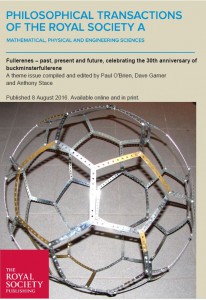From April – June 2016, our most downloaded ChemComm articles were:
Chemical generation and modification of peptides containing multiple dehydroalanines
Philip M. Morrison, Patrick J. Foley, Stuart L. Warriner and Michael E. Webb
Chem. Commun., 2015, 51, 13470-13473
DOI: 10.1039/C5CC05469A, Communication
The surface chemistry of metal–organic frameworks
Christina V. McGuire and Ross S. Forgan
Chem. Commun., 2015, 51, 5199-5217
DOI: 10.1039/C4CC04458D, Feature Article
Reduction of graphene oxide viaL-ascorbic acid
Jiali Zhang, Haijun Yang, Guangxia Shen, Ping Cheng, Jingyan Zhang and Shouwu Guo
Chem. Commun., 2010, 46, 1112-1114
DOI: 10.1039/B917705A, Communication
Rapid synthesis of zeolitic imidazolate framework-8 (ZIF-8) nanocrystals in an aqueous system
Yichang Pan, Yunyang Liu, Gaofeng Zeng, Lan Zhao and Zhiping Lai
Chem. Commun., 2011, 47, 2071-2073
DOI: 10.1039/C0CC05002D, Communication
Graphene quantum dots: emergent nanolights for bioimaging, sensors, catalysis and photovoltaic devices
Jianhua Shen, Yihua Zhu, Xiaoling Yang and Chunzhong Li
Chem. Commun., 2012, 48, 3686-3699
DOI: 10.1039/C2CC00110A, Feature Article
Nanostructured electrochromic smart windows: traditional materials and NIR-selective plasmonic nanocrystals
Evan L. Runnerstrom, Anna Llordés, Sebastien D. Lounis and Delia J. Milliron
Chem. Commun., 2014, 50, 10555-10572
DOI: 10.1039/C4CC03109A, Feature Article
A facile synthesis of UiO-66, UiO-67 and their derivatives
Michael J. Katz, Zachary J. Brown, Yamil J. Colón, Paul W. Siu, Karl A. Scheidt, Randall Q. Snurr, Joseph T. Hupp and Omar K. Farha
Chem. Commun., 2013, 49, 9449-9451
DOI: 10.1039/C3CC46105J, Communication
Production of few-layer phosphorene by liquid exfoliation of black phosphorus
Jack R. Brent, Nicky Savjani, Edward A. Lewis, Sarah J. Haigh, David J. Lewis and Paul O’Brien
Chem. Commun., 2014, 50, 13338-13341
DOI: 10.1039/C4CC05752J, Communication
Key processes in ruthenium-catalysed olefin metathesis
David J. Nelson, Simone Manzini, César A. Urbina-Blanco and Steven P. Nolan
Chem. Commun., 2014, 50, 10355-10375
DOI: 10.1039/C4CC02515F, Feature Article
Aggregation-induced emission: phenomenon, mechanism and applications
Yuning Hong, Jacky W. Y. Lam and Ben Zhong Tang
Chem. Commun., 2009, 4332-4353
DOI: 10.1039/B904665H, Feature Article
Comments Off on Top 10 most accessed ChemComm articles from April – June 2016















 Scientists in China have printed conductive 3D graphene structures and applied them in a wearable electronic device that can translate common sign language gestures into written text. Given the simplicity underpinning its manufacture, during which graphene ink is extruded from a syringe, this material could inject some pace into the printed electronics field.
Scientists in China have printed conductive 3D graphene structures and applied them in a wearable electronic device that can translate common sign language gestures into written text. Given the simplicity underpinning its manufacture, during which graphene ink is extruded from a syringe, this material could inject some pace into the printed electronics field.
 Two separate groups of scientists have developed methods to uncover proteins’ 3D structure inside living animal cells for the first time.
Two separate groups of scientists have developed methods to uncover proteins’ 3D structure inside living animal cells for the first time. A team of scientists has discovered
A team of scientists has discovered  Chemists mask amines’ unwanted reactivity with carbon dioxide and overcome limitations of amide formation
Chemists mask amines’ unwanted reactivity with carbon dioxide and overcome limitations of amide formation